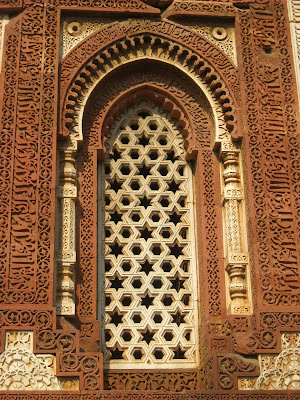 |
| Alauddin Khalji, DelhiSultenate. .google.com |
 |
| Alauddin Khalji and malik Kaufer, Khalji, a bisexual. en.wikipedia.org/ |
 |
| Alauddin Khalji, silver coins, Delhi. en.wikipedia.org/ |
In the winter of 1302–1303, Alauddin's army marched to the Kakatiya capital Warangal to ransack it. While Alauddin' himself led another army to conquer Chittor, the capital of the Guhila kingdom ruled by Ratnasimha. The siege was a long one - roughly 8 months and at last Alauddin captured Chittor. According to his courtier Amir Khusrow, he ordered a massacre of 30,000 local Hindus after this conquest. Some later legends mention that Alauddin invaded Chittor to with a view to capturin Ratnasimha's beautiful queen Padmini. Many historians reject this story as it does not have any valid records. It is more of a conjecture than of a true story.
 |
| 1870s Ala'i Darwaza, Delhi, en.wikipedia.org |
Malik Kafur, upon knowing the affluence the Hoysala and Pandya kingdoms in southern India, he took yet another expedition to go on a plundering spree. With consent from the Sultan, Kafur started his march from Delhi in November 1310. At this time, in the Pandya kingdom a war of succession was on between the two brothers Veera Pandya and Sundara Pandya. The Hoysala king Ballala wanted to take advantage of this revelry in the Pandya royal family. When Kafur's army marched into his place capital Dwarasamudra after a brief war king Ballala, to save his head, negotiated a truce, agreeing to surrender his wealth and become a tributary of Alauddin.
From Dwarasamudra, Malik Kafur's raid to the Pandya kingdom was quite profitable. Both Vira Pandya and Sundara Pandya fled their capital Madurai and the Pandy rulers never became a tributary. The Delhi army's loot was a large one - lots of treasures, elephants and horses. The Delhi chronicler Ziauddin Barani described this seizure of wealth from Dwarasamudra and the Pandya kingdom as the greatest one since the Muslim capture of Delhi.
Despite being a religious fanatic, Khaliji, was, no doubt, a good administrator and for better governance, he introduced revenue reforms, market reforms (control on prices) and social reforms such as a ban on alcohol drinking, smoking of cannabis, gambling, prostitution, etc. Adultery was a taboo during his rule. Alauddin introduced serious punishments: in the case of male adulterer he will be castrated; as for female adulterer, she will be stoned to death. He had a check on the nobility to prevent rebellions against him. His revenue reforms were popular. Alauddin Khalji's taxation system has survived into the nineteenth or even the twentieth century. From now on, the land tax (kharaj or mal) became the principal form in which the peasant's surplus was expropriated by the ruling class.
— The Cambridge Economic History of India: c.1200-c.1750,
Alauddin, being a Sunni Muslim and fanatic, is reported to have destroyed several Hindu temples during their military campaigns. These temples included the ones at Bhilsa (1292), Devagiri (1295), Vijapur (1298–1310), Somnath (1299), Jhain (1301), Chidambaram (1311) and Madurai (1311). Yet another temple affected in Tamil Nadu was Srirangam in 1311 when Malik Kaufer raided this temple town. The worst one took place on 8 March 1323 under Ulagh Khan during the Panguni festival. The ''Kozhil olugu'', book on history and temple administration of Srirangam narrates this invasion as ''Panniraayiravar mudi thiruthiya mettu kalagam'' meaning story of 12000 people (Vaishnavites) beheaded by the Muslim invader. (https://nothingtopost.wordpress.com/2018/04/02/ulugh-khans-invasion-of-srirangam)..................................... ..............................
Alauddin commissioned the Alai Darwaza, that was completed in 1311 to serve as the southern gateway leading to the Quwwat-ul-Islam mosque built by Qutb al-Din Aibak. He also began the construction of the Alai Minar, which was intended to be twice the size of the Qutb Minar, but the project was abandoned, presumably due to his death. It was a part of his plan to extend the Quwwat-ul-Islam Mosque on four sides. Though he planned to build four gates, only the Alai Darwaza could be completed. The gate is made up of a single hall whose interior part measures 34.5 feet (10.5 m) and exterior part measures 56.5 feet (17.2 m). It is 60 feet (18 m) tall and the walls are 11 feet (3.4 m) thick.
 |
| Stone window, Ala'i Darwaza, Delh, en.wikipedia.org |
 |
| Left:Qutbminar,the unfinished Alai Minar, Delhi en.wikipedia.org/ |
Alauddin died on the night of 4 January 1316. Barani claims that according to "some people", Kafur killed him and brought his body from the Siri Place and had it buried in Alauddin's mausoleum that had already been built by the ruler.)
https://en.wikipedia.org/wiki/Alai_Darwaza
https://en.wikipedia.org/wiki/Alauddin_Khalji









.webp)
